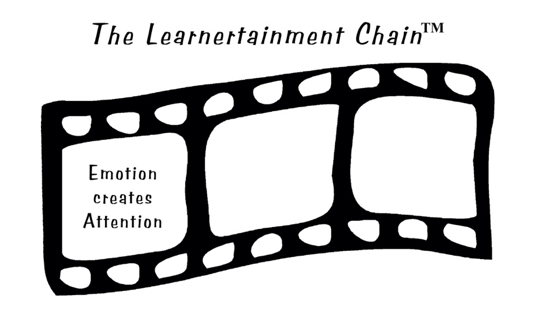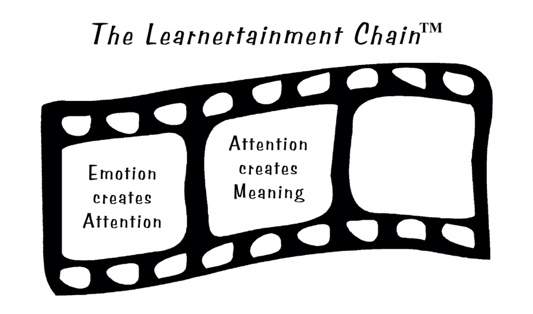When the human brain sees potential danger, it stops searching. It blocks out all extraneous stimuli and focuses tightly on the perceived threat. Even those higher-order components of the brain responsible for logic and the arts pitch in, refocusing their energies in an “all hands on deck” effort to survive. If the threat turns out to be minor, the various brain components resume their normal activities…until the next time the searchlight calls.
This dynamic is continuous: twenty-four hours a day, seven days a week, below the level of awareness, but always dictating human behavior. And as such, the searchlight cannot be ignored. Ideas, and the intellectual application of those ideas, are important but are of little consequence to a brain that feels threatened.
Fortunately for trainers, teachers, facilitators, and other learning professionals, the brain has a secondary favorite input: pleasure. In humans, survival and pleasure exist side by side. They are the Yin and Yang, the left and right, the balancing forces of our existence, and they are driven by the searchlight of emotion.

Emotion Creates Attention
The word emotion comes from the Latin exmovere, meaning “to move out of” and “to agitate.” Aristotle believed that people are persuaded not just by logic but also through emotion. Plato agreed when he said, “All learning has an emotional base.” Carl Jung added, “There can be no transforming of darkness into light and of apathy into movement without emotion.” They were all correct. Emotions start a chain of events that lead to learning.
For centuries, folklore stated that emotion was a creature of the heart. As science gained ascendancy over folklore, emotions were thought to be a function of the brain. Recent research demonstrates that both folklore and science had it right. Emotion is generated in the brain AND the body.
Emotions affect our whole body, including our heart, lungs, stomach, skin, and immune and endocrine systems. If you think back through your own life experience, you instinctively know this to be true. We have all felt the goosebumps of fear, the sweat of nervousness, and the rapid breathing that comes from excitement. A “gut reaction” is just that, an emotional signal from the gut – we feel first and think later.
The body’s up-front focus on feelings is critical to our survival. In situations where life or death stands in the balance, split-second responses are essential. Emotion serves the purpose of identifying general threat levels. The emotional meaning of the situation captures the brain’s attention and helps it make snap fight-or-flight decisions. Although people may be able to rationalize their emotions, the truth is that emotions control them. Even when people overpower emotions with logic, the feelings that created the emotion remain, often forever.

Attention Creates Meaning
Once emotion has taken hold, the brain shifts into a heightened level of attention. This heightened level is stressful. It cannot be maintained for long. To protect itself from overload and to free up capacity for the next potential threat, the brain quickly determines the meaning of the emotion. It explores its memories, searching for something comparable. Once a comparison is found, the brain concocts a mental concept or model to explain the emotion. It then uses this explanation to determine an appropriate response. This is not to suggest that the brain has made an intellectual decision. Rather, it has captured the general meaning of what has happened and selects a correct response accordingly.
During this process, the initial stimulus is held in short-term memory. Short-term memory is that portion of memory devoted to the things that must be remembered in the moment, but may not be significant in the future. Short-term memory has finite capacity and can only store items for around 30 seconds. Consequently, the brain quickly determines the meaning of the information and its potential future importance.

Meaning Creates Memory
With an item’s meaning defined, the event is codified. Information of little long-term value is discarded. Information that is, or may be, meaningful in the future is forwarded into long-term memory.
It is in the long-term memory where learning, if successful, resides. Unlike short-term memory, long-term memory has an almost infinite capacity. Once an item has passed into the brain’s long-term memory, it remains on file, waiting for the searchlight’s call. The item, although nearly forgotten, remains so potent that the correct emotional stimuli – a song, a smell, a visual, or a combination of sensory inputs – can bring it flooding back into conscious memory. And often, the memory returns so vividly that it seems as if the event just occurred!
This depth of memory provides learning professionals with an advantage. Knowing that an emotional stimulus remains powerful when locked in the memory, it’s in the instructor’s best interest to tie learning to emotion. All that is required is a strong emotional trigger, like entertainment.

Entertainment Creates Emotion
In today’s world, entertainment is everywhere. We see it in advertising, in news programming, in “reality” television, in TV-based education, and in businesses ranging from restaurants to retail stores to theme parks.
We have become a society obsessed with entertainment. According to the U.S. Bureau of Labor Statistics, in 2022, the average American spent $3,458 on entertainment each year, or an average of 4.7% of income. That amount is more than the combined amounts spent on apparel (2.7%) and education (1.8%).
It’s not an accident that entertainment rules. As survival concerns receded from the foreground, people became individually focused. In past generations, assembly-line style orderliness and a “Yes, Sir!” willingness to follow commands were valued. Today, people instead focus on their individual needs, with little adherence to the dictates of others. They expect to be catered to and will patronize organizations that provide enjoyment.
In response, many organizations have entertainmentized their products. The result is a culture in which the lines between entertainment and non-entertainment are evaporating. Entertainment content is becoming the norm. Shakespeare was correct before his time. The world IS a stage.
Learnertainment®
It is appropriate that the world is a stage. The entertainment arts were created to complement the brain’s searchlight quest for danger. At the dawn of human history, pleasure, although secondary to survival, was always present. Pleasure had a survival function. Food and sleep were required for survival and thus were pleasurable. The brain also required excess capacity for emergencies, but excess capacity had to be exercised. The entertainment arts provided the exercise regimen.
Eventually, survival was assured, but the excess capacity remained. Fortunately, the portion of the brain that processes negative emotions, the right hemisphere, is also attracted to the entertainment arts. People began to refocus this region on pleasurable experiences.
Whether the forum was a nighttime cave fire, the Greek coliseum, the Elizabethan stage, the vaudeville palace, Broadway, the movies, television, or most recently, the Internet, a straight line can be traced from the decrease of survival needs and the increase of emotionally based entertainment.
In this context, then, the learning professional’s challenge is to match society; to make classroom instruction equal in entertainment value; to lift classroom instruction from expected to exceptional, from required to desired, from painful to pleasurable, and in short, to make it fun!
The key to fun is the solicitation of positive learner emotions. As we have discovered, negative emotion rarely sleeps, especially in the classroom. When the brain focuses on survival, it focuses completely. Worse yet, learning requires the exploration of unfamiliar territory, and when the incoming information doesn’t fit any recognizable pattern, the brain tags the information as a potential threat. The searchlight stops, and learning is blocked. Smart learning professionals draw the searchlight toward positive emotional energy.
Here’s where Learnertainment® can help. Entertainment-based content relaxes the right hemisphere, in effect, babysitting it and keeping it busy with things it likes: cartoons, music, games, activities, and visuals. Once the right hemisphere is playfully engaged, learning can commence without negative blocking emotions. Attention is riveted on the positive aspects of learning. In short, Learnertainment® distracts them so that you can slip some learning into them.
So the searchlight scans, never to stop. It’s no matter. Learnertainment® welcomes the spotlight. It beckons that light, draws it in, entices it to stop, and performs for it, demanding it pay attention. And with attention secured, the spotlight shines where it should, on learning.
































